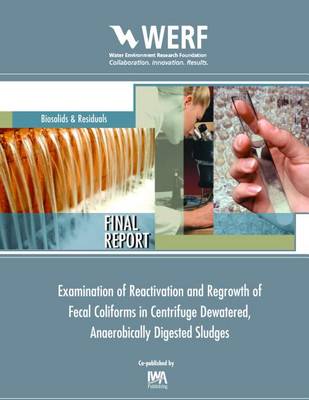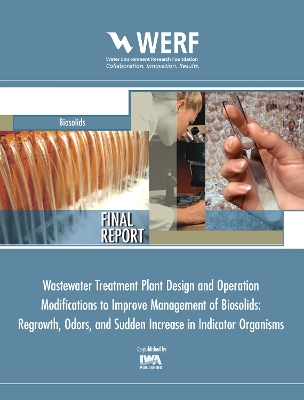WERF Research Report
5 total works
Understanding Factors Affecting Polymer Demand for Thickening and Dewatering
by Matthew J. Higgins and Sudhir Murthy
Published 31 March 2006
Polymer demand varies considerably for different digestion processes as well as the same digestion processes at different locations and the reasons for these differences are not known. The objectives of this research were to develop a mechanistic understanding for these differences. The differences were hypothesized to depend on both the amount of charge in a sludge sample and the characteristics of the polymer. The first phase of the research was aimed at establishing the component of the sludge that creates the polymer demand and the second phase was aimed at understanding the interactions of polymers with the components of sludge. A number of samples were collected and analyzed for factors affecting polymer demand. The samples incluced MLSS, RAS, conventional aerobically and anaerobically digested, thermophilic anaerobically digested, temperature phased anaerobically digested, and an auto-thermal aerobically digested sample. Results from the first phase showed a good linear correlation between the optimum polymer dose (OPD) and biocolloid concentration as measured by soluble protein and polysaccharide concentration. In other words, these small particles (less than 4.2 mm created a significant portion of the polymer demand, especially for digested sludges. Conditioning samples with different polymers (varying charge density and configuration, linear, branched and hydrophobic) showed that the key characteristic in determining OPD is the charge density of the polymer. The shear associated with several full-scale dewatering devices was measured and quantified using the unitless Gt term. In addition, several field trials were performed to show the impact of Fe addition on polymer demand as well as methods to reduce the shear associated with high solids centrifuges.
The sudden increase in indicator bacteria, including fecal coliforms (FCs) and E. coli, was evaluated at several full-scale facilities, in addition to the increase measured during cake storage. The results showed that the sudden increase was a statistically verifiable occurrence at some facilities, but not all, as was the additional increases measured during cake storage. The sudden increase and growth were much more prevalent in processes that utilized centrifuge dewatering compared to belt filter press dewatering. The sudden increase appears to be a result of the reactivation of indicator bacteria that become reversibly non-culturable (RNC) during digestion. Although other hypotheses, such as contamination and presence of inhibitors, cannot be ruled out in all cases. Only one plant that was sampled with high solids centrifugation did not show reactivation and/or regrowth and this plant was different from others in that it utilized thermophilic reactors in series. The results showed a good correlation between the digestion temperature and the reactivation potential and amount of reactivation measured after dewatering. As temperature of digestion increased, the amount of reactivation increased (for plants with reactivation). Similarly, this was generally true, on average for the extent of regrowth. The digestion SRT and VS reduction did not correlate well with reactivation or regrowth.
Effect of Aluminum and Iron Addition during Conditioning and Dewatering for Odor Control
by Matthew J. Higgins
Published 10 March 2010
The objectives of this research were to investigate the factors impacting the effectiveness of metal salts in reducing the production of volatile organic sulfur compounds (VOSCs) in biosolids, with the goal of developing recommendations for applying metal salt addition in the field for odor reduction. The research examined a number of factors which could impact the effectiveness of metal salt addition which included chemical dosage, types of chemicals, location of the addition point, the shear applied to the solids, and different biosolids sources.
The results showed that metal salt addition can reduce VOSC production, but their effectiveness is especially impacted by the shear applied to the biosolids. Greater amounts of shear resulted in greater dosages required to achieve VOSC reduction. Comparison of different metals including, alum, polyaluminum chloride, sodium aluminate, ferric chloride, ferrous chloride, ferric sulfate, ferrous sulfate, zero-valent iron and magnesium chloride showed that all could reduce VOSC production, and some worked slightly better than others, but none were vastly superior to the others. In special cases where a biosolids produced higher quantities of hydrogen sulfide, addition of iron based chemicals generally had lower hydrogen concentrations than aluminum based chemicals, likely due to iron-sulfide precipitation. However, addition of sodium aluminate also reduced hydrogen sulfide, mainly due to the increased pH above which hydrogen sulfide volatilizes. Little differences were found when comparing the chemical addition points during conditioning, either before, with, or after the polymer. Addition directly to the cake was also effective. The addition of metal salts can be applied to reduce the production of odorants, although it is difficult to predict the dosage that will be required without laboratory and possibly pilot testing.
The results showed that metal salt addition can reduce VOSC production, but their effectiveness is especially impacted by the shear applied to the biosolids. Greater amounts of shear resulted in greater dosages required to achieve VOSC reduction. Comparison of different metals including, alum, polyaluminum chloride, sodium aluminate, ferric chloride, ferrous chloride, ferric sulfate, ferrous sulfate, zero-valent iron and magnesium chloride showed that all could reduce VOSC production, and some worked slightly better than others, but none were vastly superior to the others. In special cases where a biosolids produced higher quantities of hydrogen sulfide, addition of iron based chemicals generally had lower hydrogen concentrations than aluminum based chemicals, likely due to iron-sulfide precipitation. However, addition of sodium aluminate also reduced hydrogen sulfide, mainly due to the increased pH above which hydrogen sulfide volatilizes. Little differences were found when comparing the chemical addition points during conditioning, either before, with, or after the polymer. Addition directly to the cake was also effective. The addition of metal salts can be applied to reduce the production of odorants, although it is difficult to predict the dosage that will be required without laboratory and possibly pilot testing.
Examination of Reactivation and Regrowth of Fecal Coliforms in Anaerobically Digested Sludge
by Matthew J. Higgins and Sudhir Murthy
Published 30 September 2006
In a recent study of anaerobically digested solids from seven wastewater treatment facilities, counts of fecal coliform bacteria increased after dewatering at four of the facilities tested. Immediately after centrifugation, fecal coliform counts increased from very low or nondetectable levels, often by as much as several orders of magnitude, at the four facilities where increases were observed. This study only looked at seven facilities and only facilities using anaerobic digestion and high-solids centrifugation for dewatering; numerous other stabilization and dewatering processes are also widely used. The study identifies some potential control methods and mitigation strategies that utilities could use to reduce coliform levels and provides information on the following: Procedures and test methods that can be applied to assure measures for pathogen reduction are being achieved. Potential mitigation options (e.g., changes to digester hydraulics, dewatering chemical additions, or longer-term storage) that might be considered by a facility to achieve desired reductions in both pathogenic and indicator organisms. Available Online Only
Available as eBook only
The overall goal of this project was develop approaches to manage the issues of regrowth, odors, and sudden increase (ROSI) of indicator and pathogenic bacteria in biosolids.
The project entailed two phases. The first phase was focused on filling critical research gaps that provided the fundamental insights for developing solutions to these issues which includes method development. The second phase focused on developing and implementing solutions in the field.
The hypothesis that sudden increase is a result of incomplete inactivation of indicators was supported by the results from this work. The results suggest that Method 1680 underestimates the viable density of indicators in samples after thermal treatment. In addition, that results showed that to achieve complete inactivation of indicators, a slightly higher time-temperature regime will be needed and this new "best practices" time-temperature curve has been developed as part of the work. It should be emphasized that the current EPA time-temperature requirements appear to be sufficient for Salmonella, the bacterial pathogen used in the regulations. Several processes that utilize temperature about 75 DegreesC were able to eliminate SI. Gas chromatography-olfactometry was used to identify the persistent/long term odorants in centrifuged biosolids. The main persistent odorants contributing to cake odors were indole, skatole, p-cresol, and butyric acid. Interestingly, all of these compounds are breakdown products of organics such as proteins, carbohydrates and fats, suggesting that processes which eliminate these precursors will help reduce odors in biosolids. Odor panel results showed that the level of odors measured after longer term storage, was correlated to the shorter term TVOSC concentrations. Mechanistically this was expected since the short term TVOSCs and longer term odorants are produced by similar pathways.
Several amendments added to centrifuge cake were able to significantly reduce odors and/or regrowth. The incubation of anaerobically digested biosolids with protein degrading enzymes resulted in additional gas production as well as a reduction in odors after dewatering. Also, better digestion was associated with lower odors, and primary sludges produced greater odors compared to secondary sludges.
The overall goal of this project was develop approaches to manage the issues of regrowth, odors, and sudden increase (ROSI) of indicator and pathogenic bacteria in biosolids.
The project entailed two phases. The first phase was focused on filling critical research gaps that provided the fundamental insights for developing solutions to these issues which includes method development. The second phase focused on developing and implementing solutions in the field.
The hypothesis that sudden increase is a result of incomplete inactivation of indicators was supported by the results from this work. The results suggest that Method 1680 underestimates the viable density of indicators in samples after thermal treatment. In addition, that results showed that to achieve complete inactivation of indicators, a slightly higher time-temperature regime will be needed and this new "best practices" time-temperature curve has been developed as part of the work. It should be emphasized that the current EPA time-temperature requirements appear to be sufficient for Salmonella, the bacterial pathogen used in the regulations. Several processes that utilize temperature about 75 DegreesC were able to eliminate SI. Gas chromatography-olfactometry was used to identify the persistent/long term odorants in centrifuged biosolids. The main persistent odorants contributing to cake odors were indole, skatole, p-cresol, and butyric acid. Interestingly, all of these compounds are breakdown products of organics such as proteins, carbohydrates and fats, suggesting that processes which eliminate these precursors will help reduce odors in biosolids. Odor panel results showed that the level of odors measured after longer term storage, was correlated to the shorter term TVOSC concentrations. Mechanistically this was expected since the short term TVOSCs and longer term odorants are produced by similar pathways.
Several amendments added to centrifuge cake were able to significantly reduce odors and/or regrowth. The incubation of anaerobically digested biosolids with protein degrading enzymes resulted in additional gas production as well as a reduction in odors after dewatering. Also, better digestion was associated with lower odors, and primary sludges produced greater odors compared to secondary sludges.




